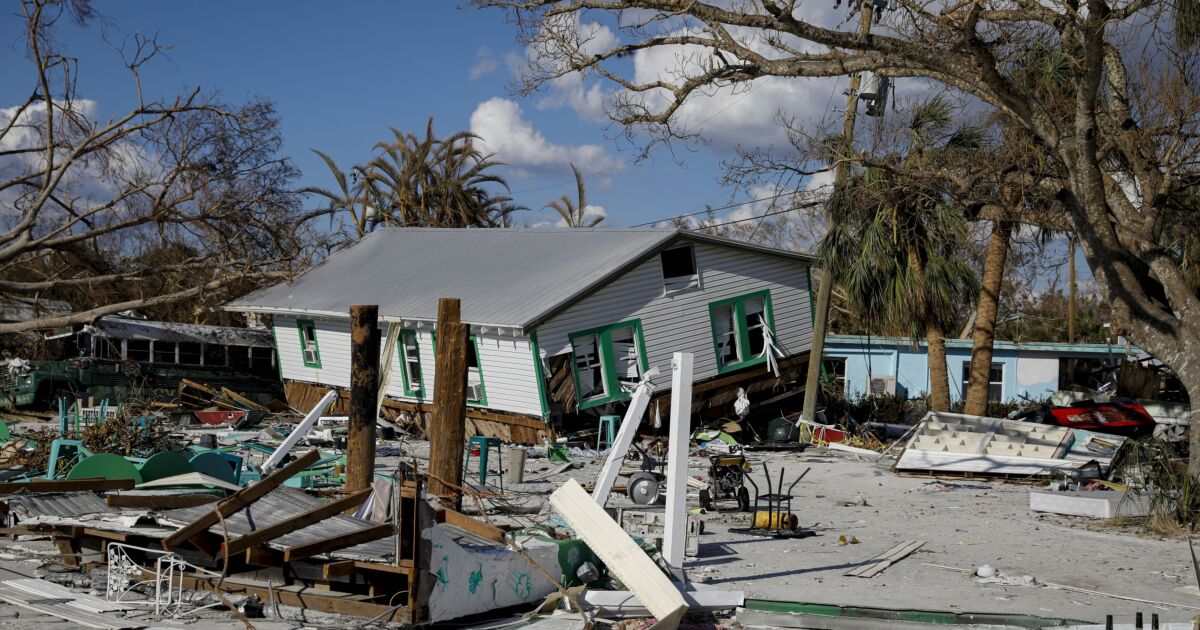After Hurricane Ian, some sectors in Florida face fiscal stress
7 min read
Some sectors of Florida’s economy may be vulnerable to fiscal stress in the wake of Hurricane Ian’s destructive march across the state.
According to a report from Municipal Market Analytics, some risky sector credits may be in a for a difficult time ahead.
The Florida hurricane is likely to cause some impairments and a few first-time payment defaults, with risky sector borrowers being the most likely to default, MMA said.
“This expectation has a bit more conviction for Florida than it might for other states because of Florida’s history of risky sector municipal credit problems since 2009, when data became available to track this,” MMA said in the report released last week.
Hurricane Ian came ashore in southwestern Florida as a Category 4 storm on Sept. 28. It took a northeasterly path through central Florida before heading to the Atlantic Ocean and then making a second landfall in South Carolina on Sept. 30.
The storm’s evolving death toll has passed 100has passed 100in Florida. It also caused widespread residential and commercial property damage in several communities.
Lee, Sarasota and Charlotte Counties were those most affected and saw significant damage to infrastructure and residential homes.
“Almost entirely because of the state’s universe of land secured, senior living, IDB (industrial development bond) and charter school borrowers, Florida has provided more municipal payment defaults than other state in nine of the last 14 years. And it has ranked in the top five of most-impaired (or most-defaulted) states in 12 of those years,” according to the report written by Matt Fabian, MMA partner, and Lisa Washburn, MMA chief credit officer.
This data “suggests an underlying permissiveness in state borrowing rules for risky sector credits,” according to MMA, which the report said could mean an increase in impairments.
Conversely, MMA said that high-grade municipals, Florida’s safe sector credits such as general obligation and water and sewer bonds, have performed well over the past few years and look likely to continue to do so.
State officials say the state government and state-backed insurers remain in strong positions.
S&P Global Ratings rates 24 transportation infrastructure entities in Florida, the vast majority of which saw little or no storm-related impact.
Even the partial collapse of the Sanibel Causeway, a bond-financed toll connection from the mainland to Sanibel Island, isn’t expected to cause a ripple for bondholders. It’s one of three crossings in the Lee County system of toll bridges, rated at an underlying A-plus by S&P Global Ratings, on CreditWatch Negative, and underlying A2 with stable outlook by Moody’s Investors Service.
The three-mile-long tolled causeway and bridge structure serves residents and tourist-based island resorts on Sanibel Island while the other two bridges in the system — Cape Coral and Midpoint Memorial — provide connections between the cities of Cape Coral and Fort Myers.
In fiscal 2021, the Sanibel Causeway represented 33% of $43.7 million gross revenues of the transportation facility’s toll system, S&P said.
“While the full extent of the damage is still being assessed, the temporary closure of the causeway, the loss of toll revenue from other damaged segments of the toll system and a potential increase in leverage to fund reconstruction will pressure the enterprise,” Moody’s said.
As of the end of fiscal year 2021, the Lee County Toll Enterprise had $32 million in available liquidity, about 777 days cash on hand, which offers a cushion to address immediate costs, Moody’s said.
In 2014, Lee County issued $106.57 million of Series 2014 tax-exempt transportation facilities refunding revenue bonds for the Sanibel Causeway, due 2015-2035. Furthermore, the deal was insured by Assured Guaranty Municipal Corp.
On Tuesday, Gov. Ron DeSantis said temporary repairs to the causeway will allow a convoy of power restoration equipment, supplies and crews access to the island and continue restoration efforts.
The Florida Department of Transportation is working to restore access to the island for residents and the work is expected to be finished by the end of the month.
S&P noted that regional airport, port and toll road operators can withstand temporary interruptions in operations and revenue losses such as the suspension of tolls, because of existing liquidity and reserve levels, prudent budgeting, proper risk mitigation through insurance coverage, availability of disaster relief funds, access to capital and bank lending markets.
Moody’s said strong liquidity would let most toll roads withstand any short-term revenue disruption.
“Florida’s toll roads maintain strong liquidity to be able to withstand short-term revenue disruptions caused by storms and flooding,” Moody’s said, “but entities that sustained physical damage may experience longer-term loss of revenue and will bear upfront reconstruction costs until they receive potential state and federal reconstruction funds.”
Fitch Ratings said the damage from the hurricane on toll roads, ports and airports was expected to be minimal and short-lived.
“None of the Fitch-rated transportation credits sustained long-term damage to facilities and nearly all opened shortly after the storm left,” Fitch said. “Projects have strong cash reserves to manage any short-term cost spikes and revenues will see little disruption, with key financial metrics unaffected.”
The hurricane’s impact on Florida’s airports was less severe.
Kroll Bond Rating Agency rates Miami International Airport, Tampa International Airport, Orlando International Airport and Southwest Florida International Airport, which serves Fort Myers, where Ian hit hardest. Miami was outside the range of the storm and was operational throughout the hurricane while Tampa, Orlando, and all southwest Florida airports closed for the duration.
Damage was limited with power, potable water, and access road flooding the primary issues, Kroll said. Impacts on landing fees and non-airline revenues won’t be known until next month.
“All KBRA-rated airports have ample liquidity. KBRA will continue to monitor passenger volumes to affected areas to ascertain whether the storm damage has any long-term travel pattern impacts,” Kroll said.
Moody’s said that while airports will face short-term revenue losses, adequate liquidity levels will support credit quality.
“Florida airports are likely to experience no more than short-term disruptions related to Ian,” Moody’s said. “However, the extensive property damage that Ian caused in Lee County will likely reduce the availability of vacation rentals in the area and limit demand while properties are restored.”
Lee County sold two bond issues for its airport in 2021, which is owned by the county and operated by the Lee County Port Authority. The county sold $217.67 million of airport revenue bonds last October and $139.56 million of airport revenue refunding bonds in June 2021.
S&P said it rates more than 375 local governments in Florida, with around 190 located in the path of the storm. S&P said that while it was too soon to speak with all affected issuers, it reviewed the credits in Ian’s path, looking at cash and reserve levels historically as well as disaster planning efforts.
“At present we believe reserves and liquidity are strong enough to support credits in our general obligation portfolio with general fund reserves of affected local government credits ranging from 19% to 135% of expenditures,” S&P said.
Moody’s said most of the municipalities that it rates have ample liquidity.
“We rate about 70 cities and counties in the state that were affected by Ian. Most have robust available reserves and liquidity to support recovery projects until they receive state and federal reimbursements,” Moody’s said.
“I think the biggest risk on the local government side is long-term deterioration of the tax base that’s been destroyed,” Moody’s assistant vice president Lauren Von Bargen told The Bond Buyer recently. “But historically in Florida we’ve seen tax bases being rebuilt after storm like this.”
Other sectors that could be impacted include not-for-profit health care, public power and housing.
“Given their location, many Florida hospitals and senior living communities have experience dealing with hurricanes and other severe weather events and they have very detailed disaster preparedness plans that they can initiate in anticipation of a major storm such as Hurricane Ian,” S&P said.
S&P said that supply chain issues and rising inflation costs along with liquidity will determine public power rating resilience.
“The extensive service outages several public power and electric cooperative utilities and their customers are experiencing will likely disrupt revenues for an indeterminate time while service is being restored and structures are repaired or rebuilt,” S&P said. “Compared with pre-pandemic hurricanes, the costs of service restoration and restoration times could be particularly acute following Hurricane Ian because we believe electric utilities will face severe supply chain hurdles as they source replacements for damaged infrastructure.”
Jenny Poree, S&P sector lead for the water and sewer utilities group, said these issuers will benefit from a high level of liquidity.
“Most of these credits, although there’s going to be significant rebuild, had very strong financial underpinnings going into the storm and the liquidity will help them recover, even if this recovery will be significantly longer than the historic norms,” Poree told The Bond Buyer recently.
Municipal electric and gas utilities are largely insulated, Moody’s said.
While these utilities face lost revenue and unexpected rebuilding costs, Moody’s said the risks are largely mitigated by their liquidity and their ability to adjust rates and pass on additional costs to customers.
For public housing issuers, liquidity will be key, S&P said.
“We expect the stability of the ratings for U.S. public finance rental housing properties suffering from storm damage will vary in the near term with the level of damage, sufficiency of capital reserves, and speed at which business interruption and property and casualty insurance starts to flow,” S&P said.
As with other credits, S&P said that liquidity will be key to sustained financial performance for properties that may have damaged units offline or with other significant needed repairs.
“We have already noted rising insurance premiums for multifamily properties — an average of about 30% between fiscal years 2017 and 2019 — and expect Ian will contribute to this trend,” S&P said.







